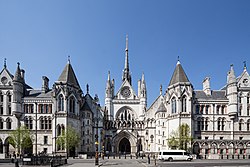
Back Каралеўскі судны двор Byelorussian Královský soudní dvůr Czech Royal Courts of Justice Danish Royal Courts of Justice German Reales Tribunales de Justicia Spanish Royal Courts of Justice Basque Royal Courts of Justice Finnish Cour royale de justice French בתי המשפט המלכותיים HE Royal Courts of Justice Italian
| Royal Courts of Justice | |
|---|---|
 The façade onto Strand | |
 | |
| General information | |
| Status | Completed |
| Type | Court |
| Architectural style | Gothic Revival |
| Address | Strand City of Westminster WC2A 2LL |
| Town or city | London |
| Country | England |
| Coordinates | 51°30′49″N 0°06′48″W / 51.51361°N 0.11333°W |
| Current tenants | HM Courts & Tribunals Service |
| Groundbreaking | 1873 |
| Opened | 1882 |
| Cost | < £1 million |
| Technical details | |
| Material | Portland stone ashlar and red bricks with granite, marble and red sandstone dressings and slate and lead roofing |
| Floor count | Five |
| Design and construction | |
| Architect(s) | George Edmund Street |
| Main contractor | Messrs Bull & Sons |
| Other information | |
| Public transit access | |
| Website | |
| Official website | |
Listed Building – Grade I | |
| Official name | Royal Courts of Justice: The Law Courts, Screen Walls, Gates, Railings and Lamps |
| Designated | 5 February 1970 |
| Reference no. | 1264258 |
The Royal Courts of Justice, commonly called the Law Courts, is a court building in Westminster which houses the High Court and Court of Appeal of England and Wales. The High Court also sits on circuit and in other major cities. Designed by George Edmund Street, who died before it was completed, it is a large grey stone edifice in the Victorian Gothic Revival style built in the 1870s and opened by Queen Victoria in 1882. It is one of the largest courts in Europe. It is a Grade I listed building.[1]
It is located on the Strand within the City of Westminster, near the boundary with the City of London (Temple Bar). It is surrounded by the four Inns of Court, St Clement Danes church, the Australian High Commission, King's College London and the London School of Economics. The nearest London Underground stations are Chancery Lane and Temple. The Central Criminal Court, widely known as the Old Bailey after its street, is about 1⁄2 mile (0.8 km) to the east—a Crown Court centre with no direct connection with the Royal Courts of Justice.